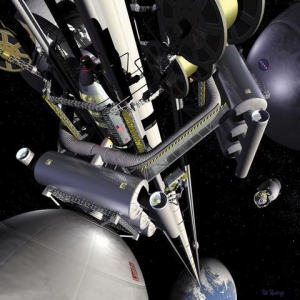 Scientists have been trying for years to develop the technology required to build an elevator to space. They would like to build a tower that is anchored to the Earth and stretches beyond geosynchronous orbit. The tower would be held under tension by natural forces. Robotic climbers would be able to transport people and equipment up and down the tower for a fraction of the cost of current space missions. It would no longer be necessary to build rockets and expend large amounts of fuel.
Scientists have been trying for years to develop the technology required to build an elevator to space. They would like to build a tower that is anchored to the Earth and stretches beyond geosynchronous orbit. The tower would be held under tension by natural forces. Robotic climbers would be able to transport people and equipment up and down the tower for a fraction of the cost of current space missions. It would no longer be necessary to build rockets and expend large amounts of fuel.
Rocket launches using current technology can cost over $400 million. Moving payloads into low-earth orbit can cost up to $10,000 per pound. Scientists are unsure how much it would cost to build a space elevator, but it would probably be much less.
NASA has been working on developing a space elevator for several years. In 2009, it awarded LaserMotive $900,000 for demonstrating a way to power a space elevator with lasers. It is also offering $2 million in its “Strong Tether Challenge” to the first company that can produce a cable with 5 gigapascals of strength.
Lockheed Martin obtained a patent to build a space elevator in 2002. It wants to build its space elevator cable from scaled-up carbon nanotubes called carbon macrotubes. Carbon nanotubes are microscopic. Lockheed Martin and some other large companies are trying to create carbon nanotubes that are strong enough to support a space elevator but not so light that it would fall back to Earth.
Earlier this year, Lockheed Martin filed a patent application for carbon macrotubes composed of at least one layer of graphene wrapped around a scaffold material. The company wants to take advantage of carbon nanomaterials’ thermal, mechanical, optical, and electrical properties; relatively high tensile strength; and high electron mobility at room temperature.
Companies have tried to spin carbon nanotube fibers into thread, but they have found that the threads’ tensile strength is less than the tensile strength of single-wall carbon nanotubes, making them impractical. However, Lockheed Martin seems to have found a way to produce carbon macrotubes in which the tensile strength of the graphene monolayer approaches about 130 gigapascals of a single-walled carbon nanotube as the thickness of the polymer layer is reduced.
Lockheed Martin is interested in using the new technology in its Perforene water filtration system. However, it could also potentially be used to construct a space elevator cable. Scientists have previously concluded that a cable would need a tensile strength of about 130 gigapascals, and Lockheed Martin’s carbon macrotubes would be strong enough.
There is still a long way to go before a space elevator becomes a reality. Even if the technology would work in theory, producing a 60,000-mile-long cable would take years. Experts estimate that a working space elevator is about 50 years away.
